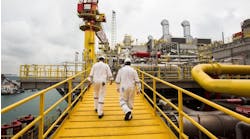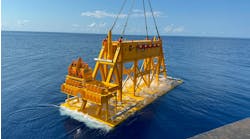Victor Schmidt
Houston
Size chasers will have to combine three or more producers
Any companies wishing to chase the new constellation of super-majors will have to combine three or more companies. Exxon and Mobil's bid to become "number one," leapfrogged both the recent BP-Amoco combination and established leader Royal Dutch/Shell. Smaller players Ocean Energy and Seagull Energy also combined to make their presence known on the chart. Hypothetically, the next three largest companies - Chevron, ENI, and Texaco - could merge to rival BP Amoco in size and reserves. If Shell decided to make a run at Chevron, it could regain its number one spot and place more distance between itself and the Exxon-Mobil contender.Effect of low prices
The ultimate effect of the price deflation in the oil markets will not be known for at least a year, while the industry adjusts. Many companies and countries cannot sustain the low price environment for long. Below are a few of the current effects:- Weak prices reduce the value of oil-in-ground (primary asset).
- Reduced cash flow directly affects profits and dividends, lowering share prices.
- Reduced borrowing capacity affects future exploration and development projects, causing delays and a general slowing of activity.
- Depletion begins to gain on reserve replacement activities.
- Growth targets must be adjusted (lower short-term).
- Management seeks a solution through merger or acquisitions.
Cost - still the primary driver
The unrelenting pressure on cost is in the forefront of everyone's mind (second only to job security) due to the global economic pullback and supply/demand imbalance in the oil markets. What is not mentioned very often is the way the application of technology drives down production costs. Our drilling systems are getting smarter. Systems that integrate well logging and drilling are now routine. The cost savings come in foreknowledge and planning information for the production engineer. Enhanced savings can be expected from "smart" well systems as they evolve.Light pipes and the color of the future
Technology drives the oilfield. At every level, the industry is applying more and better equipment, processes, and techniques. In addition, each advance requires that properly trained people implement the advance. The major management challenge is to develop and maintain the right balance of these elements to address the customer's need and generate a profit in the process. Petroleum in general, and the offshore segment in particular, is preparing to make a major technological leap driven by denser information sets and the constant need to lower production costs.The industry must have more functionality from systems: automated controls, rule-based actuator responses, and even artificially intelligent pro-action problem containment. The systems are becoming "intelligent." They must generate, interpret, and respond correctly to more data. They must be able to communicate without the intervention of a human mind for several reasons: safety, location, spill prevention/control, and cost containment.
Hydraulic systems or copper cables now link fluid pressure actuator controls at the wellhead to create oilfield level control systems. These can be further connected by either copper cable or radio/microwave systems to other centralized information control systems.
Copper-based controls will ultimately yield to thinner, lighter, higher bandwidth optical cables (light pipes) as well control and intervention systems evolve. Baker Hughes' bold vision of the "downhole factory" (Offshore, June 1998) is not many years away.
Light pipes will be driven initially by off-the-shelf light emitting diode (LED) technology. This will quickly evolve to specialized mixed systems using high-frequency spectra, perhaps even x-rays, to relay dense production and rock formation information within the wellbore and onward to oilfield control centers.
Light pipes: Extending the known model
One business model that will drive this extended lightpipes application involves the gas pipeline. Data bits have similarities to natural gas. Data bit density corresponds to pressure, and the light pipe's bandwidth corresponds to a steel pipe's pressure capacity. The system will pump data as the reservoir releases petroleum. But, the data will move in both directions and at the same time yielding real-time control of the oilfield down to the reservoir level. Just-in-time inventory control will acquire a new complex meaning.The new multi-frequency systems will have to have data translators between fluid and electrical systems, electrical and light systems, and light to satellite communication systems. Like gas compression stations and pressure reduction and distribution controls, these translators must operate with complete reliability. They will be a major element of any control system.
More hot air
The global warming debate has moved closer to the politician's holy grail: unfettered access to the taxpayer's purse. By demonizing fossil fuels and declaring them a danger to society, politicians seek to create a reason for a new global bureaucracy and new ever-growing taxes to feed it. The tool for this ploy is the environmentalist's unsubstantiated charge that man's industrial development is altering the climate. The model is Europe's abusive taxes on petroleum energy sources.To date, there is no clear scientific basis for the charge. Perhaps, energy companies need to make a better case for the benefits petroleum has brought to the world at the same time as they discuss the paucity of scientific information surrounding the primary thesis. This appears to be a money fight shrouded in a green blanket.
Copyright 1999 Oil & Gas Journal. All Rights Reserved.


